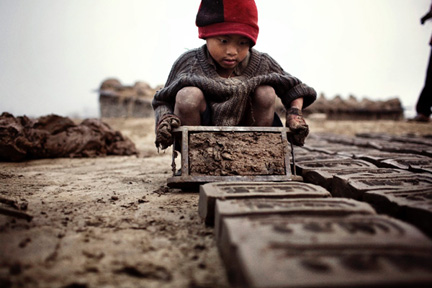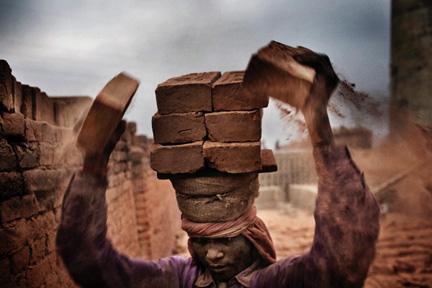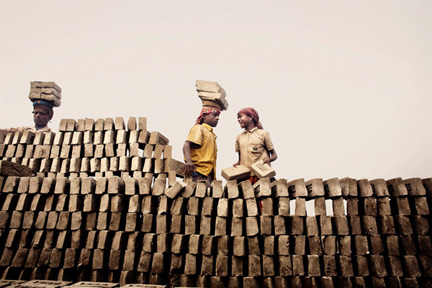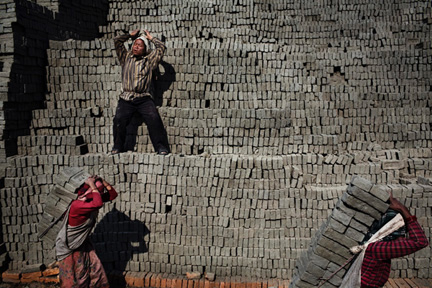Perpignan photojournalism festival
Photos of Nepali child labour win Care Humanitarian Reportage Award
Article published on the 2009-09-05 Latest update 2009-09-07 15:28 TU
“In the end I decided to visit Nepal because of the high percentage of working children,” said Catalano-Gonzago. Although the numbers of child workers might be higher in other countries, it was the fact that one in four Nepalese children is working which sent him there.

Seven in the morning. Yadhu, 4, concentrates on making bricks with moulds.
(Credit: Luca Catalano-Gonzaga)
“I took this photo at half six in the morning,” says Catalano-Gonzago. “He’d arrived at five or half five when it was still dark”.
“And I took other pictures of boys doing this work by candlelight because they were working at night in fact. They began at two in the morning and finished at four or five in the afternoon,” he says.
He says the work seems normal to the smaller children, “because their parents were doing the same thing at their age.”
“The real problem is not the parents not sending their kids to school, but the government failing to make people understand how important school and play is,” he says.
Very young children like this are working to help their parents produce the necessary number of bricks – around 1500 a day – that lets the family earn enough to eat. But the older children, Catalano-Gonzago explains, are being exploited in an unambiguous fashion. “Many come from the countryside, others are immigrants from Bangladesh or India”, he says, “these children are working either to pay off debts or because otherwise they won’t eat.”

A young worker prepares to carry 12 bricks on his / her head. Carrying the bricks produces a lot of dust that damages the workers’ health.
(Credit: Luca Catalano-Gonzaga)
“This is the second phase of production,” says Catalano-Gonzago, explaining that after the bricks are moulded and baked, they’re then carried to trucks which will transport them to dealers. “This is the transport from the ovens to the trucks. In this photo I’ve tried – I don’t know if I succeeded – to show the most damaging thing for the children, the dust.”
He explains that, although the sheer effort involved in carrying piles of 4-kilogram bricks is what often strikes people, what’s hurting these workers most is the dust.
“This is very strong harmful dust,” he says. “In fact, I learned that the children work three months, no more, and then they’re switched because they have major health problems. They’re moved on to another kind of work and others replace them.”

Krishna, 10, getting angry with a colleague who has just accidentally let a brick fall on her.
(Credit: Luca Catalano-Gonzaga)
The award for his reporting on this story is presented by Michèle Guyot-Roze, of Care France, who also sits on the judging panel. She says they created the award to encourage testimony from photoreporters about the causes that Care are fighting for. “The photos are exhibited here in Perpignan and often go on to be exhibited elsewhere, she says, “and the photos pop up elsewhere.”
“What’s important for us is that there are lots of people in the world who are made aware of, for example, child labour.” She says that since Care works in 70 countries around the world, almost any humanitarian reportage that is submitted is going to be about something the organisation is involved in.
“It’s very rare that it’s a subject that we know nothing about. It happens sometimes but it’s really quite unusual,” she says.
The judging panel doesn’t simply pull a winner out of all the entries - the first stage is to draw up a shortlist of the five best reports. The reports shortlisted this year, Guyot-Roze says, “stood out very quickly, the five of them were of an extremely high quality.”
The four other shortlisted reports were from Andrew McConnell (Panos Pictures) for his photos on refugees in the east of the DRC, James Chance (Polaris Images) for work on the inhabitants of a graveyard in Manila, Zalmaï for his work on Afghanistan and Robin Hammond for a report on the cholera situation in Zimbabwe in 2008.
Catalano-Gonzago says these kinds of reports are “difficult work because you can’t make a living from it. All these photographers doing humanitarian work are little heroes.”
“I used to work in communication so I understand the difficulty in getting this kind of work out to people, to give an outlet and manage to show people things they’re not used to seeing,” says Catalano-Gonzago. But, he says, “photography is an incredibly strong language because it’s universal - so everyone can understand it."






